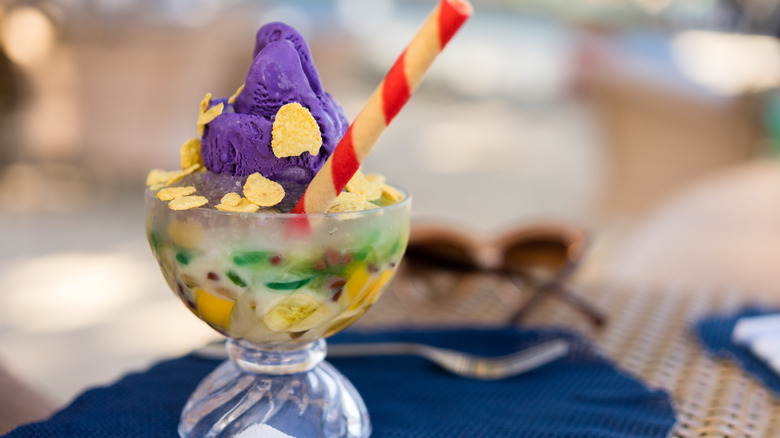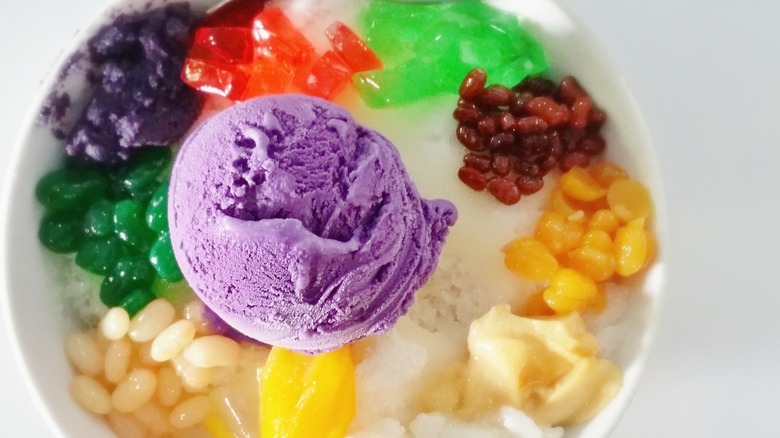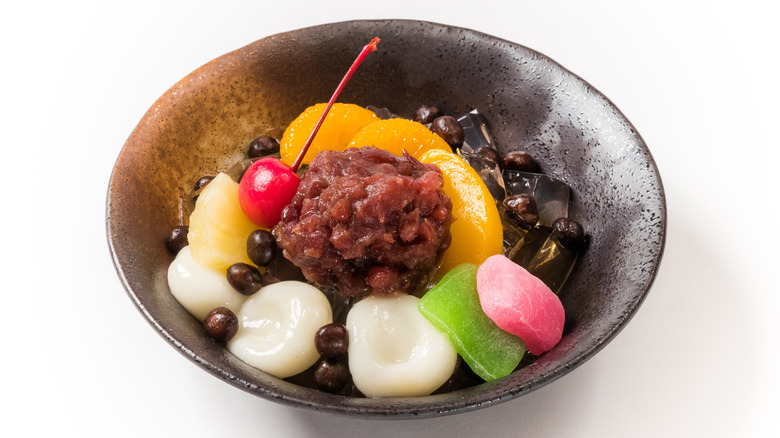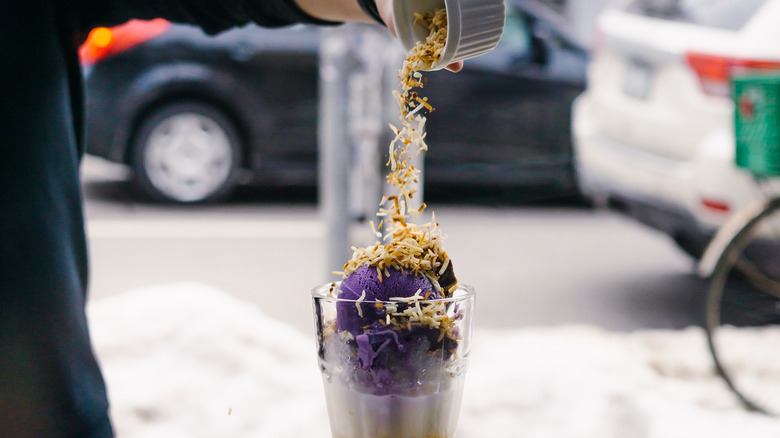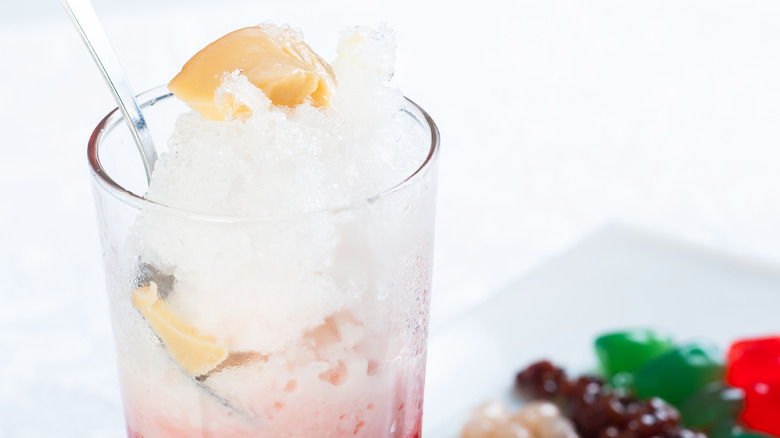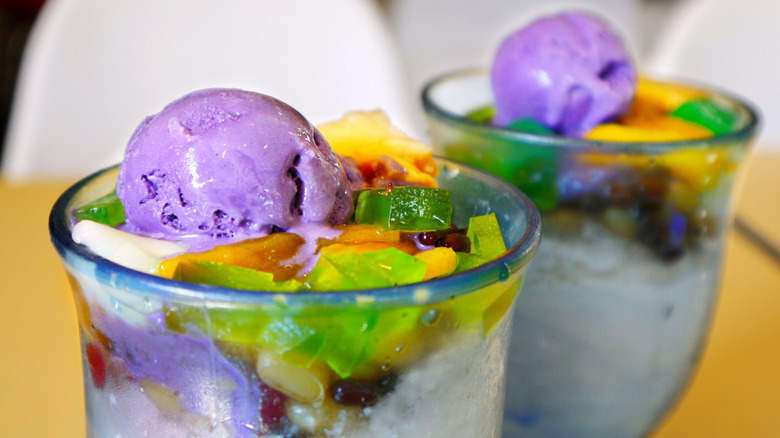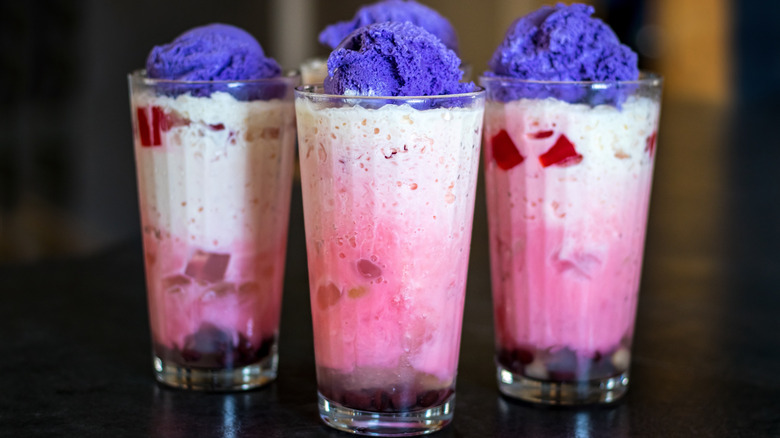What Is Halo-Halo And What Does It Taste Like?
If you didn't grow up eating it, chances are the first time you saw halo-halo, you did a double-take. It's colorful and whimsical enough to look like it was either made in Willy Wonka's factory or taken straight from the pages of a Dr. Seuss book. But the truth is, halo-halo isn't as artificial-looking or artificial-tasting as it appears. According to Ang Sarap, halo-halo is a staple of Filipino cuisine and the country's most popular summer dessert. While it's a very sweet treat, it does not taste like candy, nor is it sickeningly sweet, despite its gummy bear-colored layers.
Halo-halo can be best described as a hybrid of a milkshake, a boba tea, and a fruit parfait. It's packed full of ingredients of varying textures and flavors, from ube ice cream to fresh jackfruit, all of which are layered under a bed of shaved ice — well, that is before you mix them all up. The word halo-halo in Tagalog, in fact, literally translates to "mix-mix" in English (via Halo-Halo, Mix-Mix). The reason is pretty self-explanatory: The dessert is meant to be mixed before the first bite. Each spoonful is different from the last, which makes eating halo-halo an experience like no other.
What are the ingredients of halo-halo?
Normally, especially in desserts, less is more, but in the case of halo-halo, it's the other way around. Ang Sarap's recipe uses nine mix-ins and three toppings, and while this might seem like a lot, it's actually considered typical for halo-halo. The ingredients of halo-halo can be broken down into five basic components: sweetened beans (a combination of red beans, white beans, garbanzo beans, and corn kernels), fruit (a combination of coconut, plantain, ripe jackfruit, sugar palm, and lychee), gelatin (a combination of gulaman, boba, and nata de coco), shaved ice, evaporated milk, and ube ice cream. Oftentimes, like in Ang Sarap's version, toppings like pinipig (crispies), sweet purple yam, and leche flan are also added, though The Little Epicurean says they're usually only included in the more elaborate halo-halos you'd probably find at a restaurant.
Halo-halos don't always use the same combination of ingredients, but that is precisely what makes it so unique. As The Little Epicurean puts it, "It showcases how completely different (and sometimes random) ingredients can come together to create something tasty and wonderful."
The origins of halo-halo
Halo-halo may be a quintessentially Filipino dessert, but its origins involve both Japanese and American influence. The Culture Trip reports that halo-halo as we know it today has been evolving since the pre-war Japanese period in the Philippines. When Nippon settlers began populating the country, they brought their culture and cuisine too, introducing Filipinos to desserts such as mitsumame, and anmitsu. Mitsumame, much like halo-halo, also consists of a similar combination of fruit, red bean, gelatin, and is topped with ice cream — though anmitsu uses green tea ice cream instead of ube (via Just One Cookbook).
The most obvious difference between the two is that mitsumame doesn't have shaved ice. That was added to halo-halo in the mid-1800s, when Americans introduced ice to the Philippines, according to Halo-Halo, Mix-Mix. By 1902, when the Philippines' first ice plant was built, ice became readily available across the country. And considering the hot tropical climate, it makes perfect sense that Filipinos would want to add ice to their favorite desserts.
How are the ingredients of halo-halo made?
The halo-halo mix-ins can be made from scratch, but more often than not, because of the amount and time it takes to prepare each one, they're store-bought instead. Fresh is always better, but The Little Epicurean states that most of them are available in canned or jarred form in the Asian food aisle of your local grocery store. If you go to an Asian market like 99 Ranch Market, you'll likely be able to find them all jarred together, labeled as halo-halo mix, The Little Epicurean says. But even if you're using store-bought mix-ins for your halo-halo, Ang Sarap says it's worth it to at least make the sweetened beans yourself. It's simply one cup of dry beans boiled with half a cup of sugar and a pinch of salt.
The shaved ice, on the other hand, begins with a half-gallon of milk, which is left to freeze right in the carton. When it's fully frozen, it's removed from the freezer, covered in a towel, and pounded with a kitchen mallet. For a more consistent texture, the frozen milk is removed from the carton and carved with a knife. This, of course, is the traditional process. Most use an electric shaved ice machine now, as The Little Epicurean pointed out, but either way, as long as it's shaved and not cubes or crushed, it'll taste and mix the same.
How is halo-halo served?
Though it's eaten with a spoon like an ice cream sundae, rather than drunk through a straw like a milkshake, halo-halo is typically served in a glass rather than a bowl. This is purely in order to accommodate all the mix-ins (and any spillage that might occur). Ang Sarap says that in terms of volume, the mix-ins only take up 1/3 of the desert, while the rest is shaved ice, so using a tall glass is important.
The mix-ins are added by the spoonful in no particular order and are covered with a generous amount of shaved ice. The evaporated milk is then drizzled over the shaved ice, before the scoop of ube ice cream and the toppings are added. The last step is the actual halo-halo, or the "mix-mix." Since most of the ingredients will be sitting at the bottom of the glass, mixing is crucial to enjoying all the combinations of flavors in the halo-halo.
What does halo-halo taste like?
The Culture Trip says halo-halo recipes vary depending on the family, region in the Philippines, and personal preference, and "in some places, they even add cheese, cornflakes, polvorón or chili into the sweet mixture."
The combination of flavors, however, are all carefully determined, as Kitten Around the Kitchen explained that the time of year is always taken into account if made with fresh fruit. For example, if coconut is in season, but jackfruit isn't, the halo-halo will probably taste more coconutty. Regardless, a combination of beans, fruit, gelatin, milk, and ice is still unique enough for this dessert to have a distinct flavor, one that Kitten Around the Kitchen described as earthy, nutty, fruity, and naturally sweet in some bites, but super sweet in others. The flavor of the red beans, especially in comparison to the other sweetened beans, is the most prominent flavor, aside from the general sweetness of the dessert. Despite the chewiness of the fruit jellies and the chalkiness of the beans, the texture overall is more on the creamy side because of the ube ice cream and the milk, though the ice lends itself to a satisfying crunch too.
Does halo-halo taste different across the Philippines?
According to The Poor Traveler, there are seven popular types of halo-halo, and each is unique to its locality. Halo-halo in San Pablo City, Laguna has both spicy halo-halo made with chili, as well as salty halo-halo topped with salted egg. Halo-halo in Pagsanjan, a different part of Laguna, uses sweetened kundol, or winter melon, and instead of leche flan, it's topped with sweetened tumbong ng niyog, or the sprouts of mature coconut. Halo-halo in Pampanga, also known as pastillas halo-halo, only has three major ingredients: mashed kidney beans, cream corn, and milk pastillas, or halaya, made from carabao milk.
The halo-halo in Batangas, like the one in Pampanga, only has three major ingredients too: macapuno, pinipig, and leche flan. Instead of ice, however, this halo-halo contains coconut sherbet mixed with milk. Zamboanga City's halo-halo is sometimes called "Knickerbocker," and contains fruit and fruit gelatin, but no beans, and strawberry ice cream instead of ube ice cream. Since Davao City is known for its durian, so is their halo-halo. Davao's halo-halo uses durian jam and durian ice cream as the main components. Finally, in La Union, halo-halo is often fried (in the same way as deep-fried ice cream) and served with sticky rice, sweetened saba, and yema pandan.
